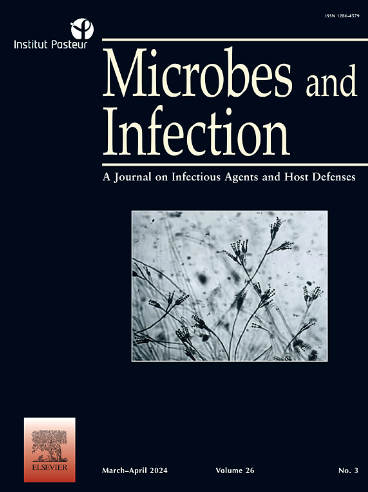Metabolic profile and disordered glycerophospholipid metabolism in recurrent vulvovaginal candidiasis
IF 2.7
4区 医学
Q3 IMMUNOLOGY
引用次数: 0
Abstract
Recurrent vulvovaginal candidiasis (RVVC) takes a toll not only on women's reproductive system but also on patients' life quality. The pathogenesis is still not fully understood. This study sought to explore metabolic profile of vaginal discharge from RVVC patients using non-targeted metabolomics and investigate potential bioactive functions of metabolites. The metabolic spectrum of RVVC patients was remarkably distinguished from healthy control and VVC patients. 324 metabolites with significant difference were detected in RVVC compared with control group, of which 239 were upregulated and 85 were downregulated. Moreover, compared with VVC, RVVC had a total of 67 significantly different metabolites including 43 upregulated metabolites and 24 downregulated metabolites. KEGG pathway analysis showed that Glycerophospholipid (GPL) metabolic pathway and PPAR signaling pathway were significantly changed in RVVC and the metabolites enriched into GPL metabolic pathway including LysoPC(18:1(11Z)), LysoPC(20:3(5Z,8Z,11Z)), PC(16:0/20:2(11Z,14Z)), PC(18:1(11Z)/18:1(9Z)) and PE(22:2(13Z,16Z)/18:3(9Z,12Z,15Z)) were significantly changed in RVVC patients and of high AUC values. In addition, the highest increased LysoPS(18:1(9Z)/0:0) in RVVC was demonstrated to not only inhibit the proliferation and migration of vaginal epithelial cells but also promote apoptosis. Molecular docking which showed strongly bind between LysoPS(18:1(9Z)/0:0) and PPAR-γ lead to a hypothesis that LysoPS(18:1(9Z)/0:0) may have an influence on RVVC through PPAR signaling pathway. Our findings provide new perspectives in understanding the pathogenesis of RVVC.
复发性外阴阴道念珠菌病的代谢特征和紊乱的甘油磷脂代谢。
复发性外阴阴道念珠菌病(RVVC)不仅对女性生殖系统造成损害,而且影响患者的生活质量。发病机制尚不完全清楚。本研究旨在利用非靶向代谢组学研究RVVC患者阴道分泌物的代谢特征,并研究代谢物的潜在生物活性功能。RVVC患者的代谢谱与健康对照组和VVC患者有显著差异。与对照组相比,RVVC中检测到324种差异显著的代谢物,其中上调239种,下调85种。与VVC相比,RVVC共有67种代谢物存在显著差异,其中43种代谢物上调,24种代谢物下调。KEGG通路分析显示,甘油磷脂(GPL)代谢途径和PPAR信号通路在RVVC中发生了显著变化,并且在RVVC患者中富集到GPL代谢途径的代谢物包括LysoPC(18:1(11Z))、LysoPC(20:3(5Z、8Z、11Z))、PC(16:0/20:2(11Z、14Z))、PC(18:1(11Z)/18:1(9Z))和PE(22:2(13Z、16Z)/18:3(9Z、12Z、15Z))均发生了显著变化,且AUC值较高。此外,RVVC中LysoPS的增加量最高(18:1(9Z)/0:0),不仅抑制阴道上皮细胞的增殖和迁移,而且促进细胞凋亡。LysoPS(18:1(9Z)/0:0)与PPAR-γ之间的分子对接表明,LysoPS(18:1(9Z)/0:0)可能通过PPAR信号通路影响RVVC。我们的发现为理解RVVC的发病机制提供了新的视角。
本文章由计算机程序翻译,如有差异,请以英文原文为准。
求助全文
约1分钟内获得全文
求助全文
来源期刊

Microbes and Infection
医学-病毒学
CiteScore
12.60
自引率
1.70%
发文量
90
审稿时长
40 days
期刊介绍:
Microbes and Infection publishes 10 peer-reviewed issues per year in all fields of infection and immunity, covering the different levels of host-microbe interactions, and in particular:
the molecular biology and cell biology of the crosstalk between hosts (human and model organisms) and microbes (viruses, bacteria, parasites and fungi), including molecular virulence and evasion mechanisms.
the immune response to infection, including pathogenesis and host susceptibility.
emerging human infectious diseases.
systems immunology.
molecular epidemiology/genetics of host pathogen interactions.
microbiota and host "interactions".
vaccine development, including novel strategies and adjuvants.
Clinical studies, accounts of clinical trials and biomarker studies in infectious diseases are within the scope of the journal.
Microbes and Infection publishes articles on human pathogens or pathogens of model systems. However, articles on other microbes can be published if they contribute to our understanding of basic mechanisms of host-pathogen interactions. Purely descriptive and preliminary studies are discouraged.
 求助内容:
求助内容: 应助结果提醒方式:
应助结果提醒方式:


